1990 Topps Ken Griffey Jr. #336: Value and Hobby Insights
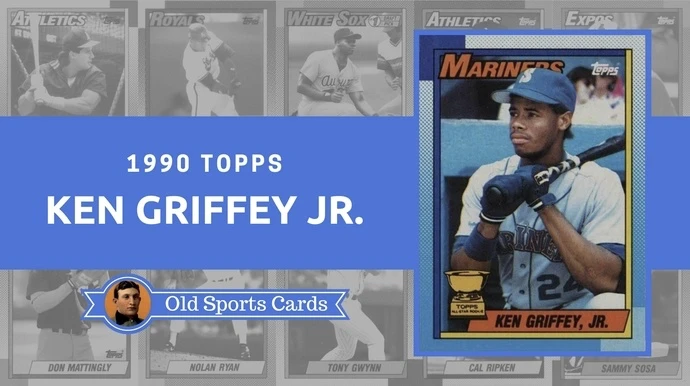
More...
From the beginning of his career, the 1990 Topps Ken Griffey Jr. card has consistently ranked among the Kid's most recognizable and sought-after cards in the hobby.
It's not his rookie card, but it's a fantastic "second-year" card...
The unique 1990 Topps design and the image of a young Griffey flanked by the "Topps All-Star Rookie" trophy give this card strong visual appeal.
As the years have gone by and Griffey's legacy as one of the game's all-time greats has been solidified by his Hall of Fame induction in 2016, this card has increased in popularity.
And in this guide, we'll look at what makes it unique, how much it's worth, and the best ways to buy and sell one.
Let's jump right in!

Ross Uitts - Owner
Love sports cards?
Get my weekly newsletter with the latest hobby updates delivered straight to your inbox!
What's It Worth?
Estimated Ungraded Value: $1 - $5
The value of a 1990 Topps Ken Griffey Jr. card will depend on its condition and whether or not a third-party company like PSA has professionally graded it.
Typically, this card will sell between $1 - $5 if it is ungraded or "raw," as the term hobbyists usually like to use for a card that remains as it was when pulled from a pack:
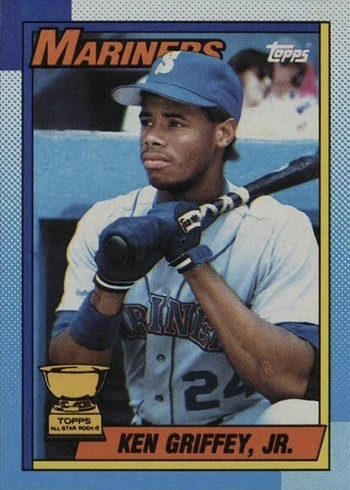
Prices for graded 1990 Topps Ken Griffey Jr. cards can vary wildly depending on the grade they receive for one simple reason: collectors are willing to pay higher prices for higher quality cards.
Most grading companies use a 1 - 10 scale to judge a card's condition, with 1 being the lowest and 10 the highest--the higher the grade the higher the value.
When assigning a grade, these companies will focus on four key areas:
- Centering: from top to bottom and left to right, centering should be as close to 50/50 as possible
- Corners: corners should be sharp with no signs of wear, bending or rounding
- Surfaces: the front and back surfaces should be free from any creasing, wrinkles, cuts, scratches or blemishes
- Edges: each of the edges should be free of any dings, dents or chipping
To give you an idea of differences in condition, notice the excellent centering, sharp corners, and beautiful surfaces of the PSA 10 Gem Mint card below versus the PSA 4 VG-EX:
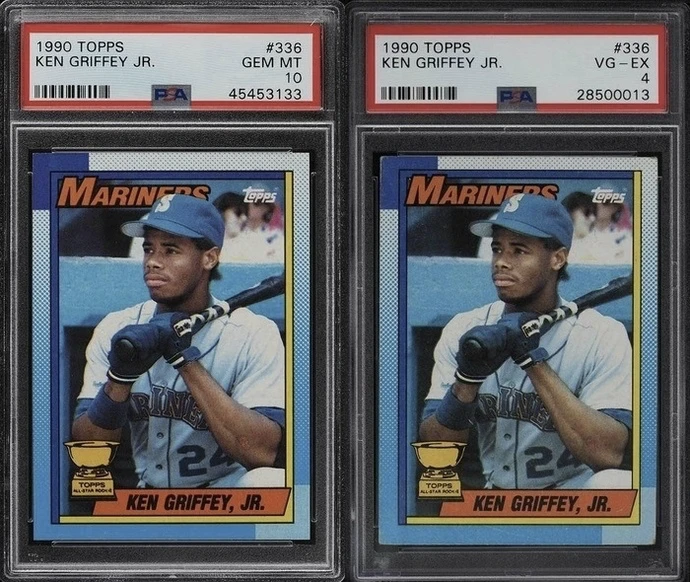
While the PSA 10 example boasts fantastic centering, sharp corners, clean edges and little to no surface issues, the PSA 4 shows fuzzy corners, worn edges, and poor centering.
The higher values for this card don't really start to kick in until it achieves a grade of 9 or 10, as the estimates are as follows:
Estimated PSA 10 Gem Mint Value: $325
Estimated PSA 9 Mint Value: $30
Estimated PSA 1 - 8 Values: $5 - $15
Facts and Insights
Sometimes, collectors mistakenly refer to this as one of Griffey's rookie cards as the card boasts the coveted "Topps All-Star Rookie" trophy in the lower-left corner.
Nearly every year since 1960, Topps included a sub-set of young and promising players that they would honor by naming to their "Topps All-Star Rookie Team" and displaying a trophy graphic on the front of their card.
However, this symbol doesn't always indicate that it's a player's true rookie card, as is the case with Griffey in this example.
Topps didn't include him in their 1989 base set, but they did insert him into their 1989 Topps Traded set, making that card his true Topps rookie card:
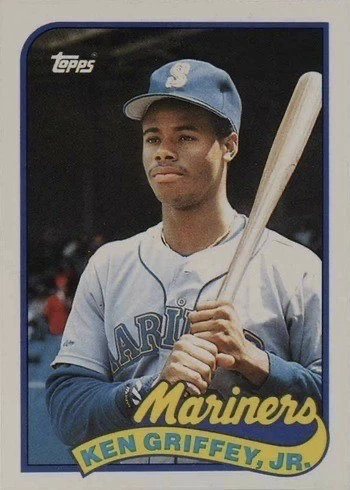
Still, his 1990 Topps issue is a fantastic card and one of the most recognizable and sought-after "second-year" cards of any player of his era.
The image of the Kid hoisting a bat over his left shoulder, the "Topps All-Star Rookie Team" trophy and the unique 1990 Topps design make it very appealing.
And if you look closely to the right of the "24" on his jersey, you'll notice a small scar near his left elbow.

Because of the printing methods that Topps used to make this card, that scar can appear in different colors.
For that reason, you'll sometimes see this card listed for sale indicating some kind of "error" related to the scar, most famously the "blood scar" error where it appears redder.
To my knowledge, the coloration of the scar doesn't make this card any more or less valuable, though some colorations may be more rare than others.
The reverse of the card uses a horizontal layout to display Griffey's card number, name, personal information, and Minor and Major League statistics.
Below the stat box is a short write-up, for which Topps has always been famous for including on many of their cards, that reads:
- "Ken graduated from Moeller (Cincinnati) High School in 1987. He played 3 years of football and 4 years of baseball. Was Baseball Player of the Year twice."
Though Topps could not have foreseen the Mariners eventually trading Griffey to the Cincinnati Reds at the time, one of Griffey's future Hall of Fame teammates in Cincinnati, Barry Larkin, also attended Archbishop Moeller High School.
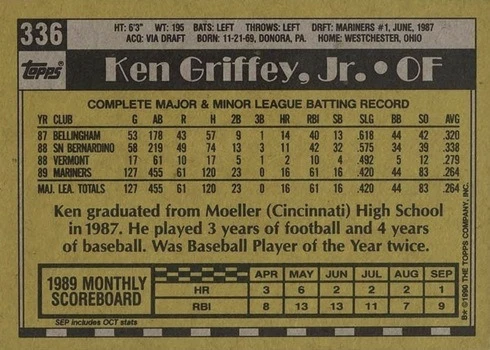
Looking At This Card In Review
During the 1987 MLB Draft, the struggling Seattle Mariners turned to Ken Griffey Jr., the incredibly talented son of former Major League star Ken Griffey Sr., as their first pick.
The hype and hysteria surrounding the Kid made the Mariners franchise confident that he was the guy who could help right the ship and move the team in a positive direction.
In 127 games during his rookie 1989 season, Ken Griffey Jr. slashed .264/.329/.420 with 16 home runs, 61 RBIs and 61 runs scored to earn third place in AL Rookie of the Year voting.
Many had hoped and maybe expected him to earn Rookie of the Year honors but it was still a standout performance in which he frequently showed flashes of his future greatness.
And from that point on, Griffey soared to new heights.
Though hampered by injuries later in his career, the Kid would put up eye-popping numbers, eventually leading to a first-ballot Hall of Fame induction in 2016.
Given his legacy as one of the best baseball players of all time and one of the game's biggest stars of his era, Griffey's cards continue to receive a lot of love in this hobby.
And though this card isn't his rookie, being his second-year card and first base, Topps card gives it incredibly strong appeal for Griffey collectors.
Though the Frank Thomas "No Name On Front" error rookie card may be the most desirable in the 1990 Topps set, Griffey's card is up there at the top along with it.

